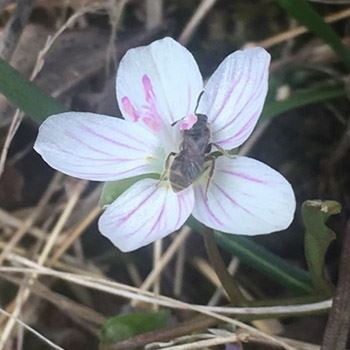Tough Plants

By Karen Menard
Spring is a tough time to be a plant on the forest floor. Each season, early blooming wildflowers face a race against the clock to quickly sprout, flower, grow, store food and set seed. They do it all between the thaw and the time trees get their leaves.
To get the job done, these plants have evolved efficient adaptations to continue their unique lifecycle from season to season. The main goal is to complete the process before the tree canopy shades out much needed sunlight.
Most early blooming plants have two types of growth phases: above and below ground. The above ground phase allows for processes to occur such as reproduction, and the production of leaves and flowers. Below ground growth surprisingly occurs during the fall and winter and encompasses the development of the buds and roots. Underground bulbs and corms are efficient, carbohydrate-rich storage centers.
The forest floors in which these plants are found are made up of nutrient-rich soils with abundant leaf litter and other organic matter. During the cold months of March and April, it is often more difficult for them to absorb soil nutrients, so these richer types of soils allow for quicker nutrient uptake. As the temperatures rise, this process becomes easier as they have more of an ability to pull food into their storage organs.
Species such as the trout lily are often found in wetter soils because they require much water to maintain the photosynthetic process during the spring. When soils become drier and plants become stressed for water, a relationship with nearby woodland fungi (called mycorrhizal association) also aids in the process of expediting water and nutrient uptake.
Hairs coating parts of hepatica, which blooms in March, and acting as insulators protect the plant from late season snowstorms and heavy frost limiting ice condensation. Bloodroot, blooming in late March or early April, also contains small hairs that protect the plant from ice condensation. Its thick, fleshy leaves resemble a fur coat that can trap warm air and shields the plant from snowstorms or heavy frost.
If you have visited a woodland early on a cold morning or cloudy day, you may have noticed the closed blooms on plants like spring beauties or bloodroot. Flower closure is energy efficient for the plant because few pollinators will be flying by in the cold or low light. Pollinators, such as queen bumblebees and other small bees and flies emerge at the same time as these plants bloom. These insects rely on spring plant pollen and nectar to sustain them with much needed proteins, lipids, amino acids and carbohydrates during a season when there is little else flowering. Pollinators are extremely important to these plants, as they need their assistance to be able to produce seed.
These spring plants that thrive so close to the thawing, sun-warmed forest floor, also have unique associations with ants. After seed production occurs, the ants become an important seed disperser for many species like bloodroot, wild ginger, great white trillium, toadshade trillium and violets. Called myrmecochory, or ant-mediated dispersal, seeds with elaiosomes (oil-rich bodies full of lipids, amino acids and proteins attached to seeds) are sought out by ants and then eaten. The remaining seed is dragged to another part of the woodland up to 10 meters away and discarded into a seed “trashpile,” which will then foster a new cycle of spring blooming wildflowers to enjoy in future seasons.
Did you know?
If you pick the bloom and the stem of a spring flower, it leaves nothing for the root and corm to feed on for another year. Some species, like white trillium may take up to eight years to flower again.
Object reference not set to an instance of an object.